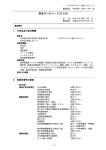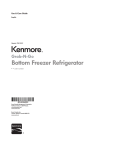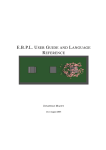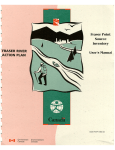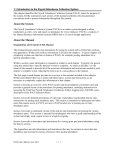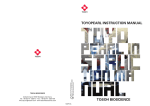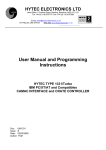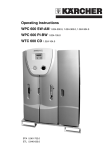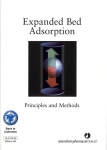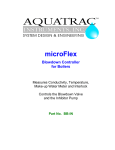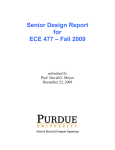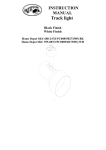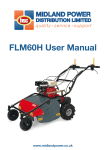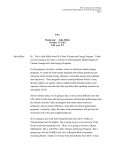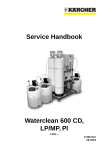Download Untitled - FreshwaterLife
Transcript
PRAIRIETM Guidance A Watson, J W Clark and L S Fryer Research Contractor: AEA Technology plc Environment Agency Rivers House Waterside Drive Aztec West Bristol BS12 4UD R&D Technical Report P68 Publishing Organisation Environment Agency Rivers House Waterside Drive Aztec West Bristol BS12 4UD Tel: 01454 624400 Fax: 01454 624409 0 Environment Agency 1997 All rights reserved. No part of this document may be reproduced, stored in a retrieval system, or transmitted, in any form or by any means, electronic, mechanical, photocopying, recording or otherwise without the prior permission of the Environment Agency. The views expressed in this document are not necessarily those of the Environment Agency. Its officers, servants or agents accept no liability whatsoever for any loss or damage arising from the interpretation or use of the information, or reliance upon views contained herein. Dissemination Internal: External: status Released to Regions Released to Public Domain Statement of Use This report provides guidance, above and beyond that provided in the User Manual, on the use of PRAIRIETM (Pollution Risk from Accidental Influxes to Rivers and Estuaries). The guidance is designed to assist first-time or infrequent users in using the package in the assessment and management of risks to potable water supplies and to the aquatic environment. Research contractor This document was produced under R&D Project No 707 by: AEA Technology plc Thomson House Risley Warrington Cheshire WA3 6AT Tel: 01925 232000 Fax01925254302 Environment Agency’s Project Manager The Environment Agency’s Project Manager for R&D Project 707 was: Mr Simon Halfacree - Environment Agency, Welsh Region R&D Technical Report P68 Executive Summary PRAIRIETM, Pollution Risk from Accidental Influxes into Rivers and Estuaries, is a software package developed by AEA Technology plc. It is designed to enable the assessment of risks to water quality from chemical spills into rivers. This Guidance document has been produced as an aid to occasional or first time users of PRAIRDF who do not require the detailed information available in the PRAIRIETM ~6.01 User’s Guide (AEA 1993) or the modelling report (AEA 1996). This document contains the bare essentials, i.e. sufficient information to run the code successfully and obtain meaningful results, in the form of simple, step-by-step examples. Guidance is also given on how to use the PRAIRIE TMdatabases to greatest effect and avoid some potential pitfalls. R&D Technical Report P68 R&D Technical Report P68 Contents 1 INTRODUCTION 5 2 WHEN TO USE PRAIRIEm 7 3 DETERMINISTIC ASSESSMENT 9 4 PROBABILISTIC ASSESSMENT 17 5 CHEMICAL SINKS 23 6 FLOW AND DISPERSION 27 6.1 TRIBUTARIES 28 7 WATER QUALITY 8 GRAPHICAL 31 OUTPUT 9 MASS BALANCE 10 CONTACT VALUES 35 ERRORS 37 NUMBERS 39 11 REFERENCES 41 Appendices APPENDIX 1 R&D Technical Report P68 PRAIRIEW DATA SHEETS R&D Technical Report P68 Introduction PRAIRIETM, Pollution Risk from Accidental Influxes into Rivers and Estuaries, is a software package developed by AEA Technology plc. It is designed to enable the assessment of risks to water quality from chemical spills into rivers. PRAIRIETM has been designed to assist in managing the risk to selected targets from accidental spills of chemicals, such targets include potable water abstraction points, as well as valued aquatic ecosystems. A brief history of the programme of work that has led to the development of the package is contained in the introductory section of the PRAIRIETM ~6.01 User’s Guide. From the beginning it was intended to develop a model which was simple to use and yet permitted probabilistic risk assessments to be undertaken. Thus, the mathematical model for dispersion is relatively straightforward. Although more complex models do exist, these require considerably more input data and greater computer resources than PRAIRIETM. PRAIRIETM was designed to be used by the non-expert, whether an industrial user, consultant or field officer from the regulatory authorities, and as such remains a simple, straight-forward computer package which can be run with the minimum of input data. There is always a compromise when developing such a package, between providing detailed information on the available modelling capabilities, and ensuring that the information supplied is tailored for the intended users. In order to address these concerns a separate ‘modelling’ report has been produced (AEA 1996) which is available for those who wish to understand the modelling details. The PRAIRIETM User’s Guide (AEA 1993) contains a great deal of information on the key features of the package and the menu commands available to the user. However, some users may require a less detailed document. This Guidance document is designed as an aid to first-time or occasional users, containing the bare essentials -sufficient information to run the code successfully and obtain meaningful results. However, as you become more familiar with running the package you may find reference to the User’s Guide or the modelling report useful. R&D Technical Report P68 R&D Technical Report P68 2 When to use PRAIRIETM As stated above, PRAIRIETM was developed to enable the assessment of risks to water quality from accidental chemical spills. However, there is more than one way to assess risk and, as such, the package can be run in a variety of ways depending on the exact question that the user wishes to answer. PRAIRIETM is best used as part of a staged approach so that risks are identified and quantified in an efficient and cost-effective manner. The initial phase of any assessment should be a screening exercise, where any chemical is analysed for the potential to cause significant adverse impact on water resources in the event of an accidental release into a river system. Those chemical hazards identified as being potentially significant, can then be assessed in more detail taking into account on-site features which may mitigate against the severity of any spill .This approach is consistent with the Environment Agency’s Rapid Risk Assessment protocol which is designed to identify and assess priority risks in a systematic way. As part of a screening exercise it is expected that PRAIRIETM will generally be run first in deterministic mode. Deterministic is a term used to describe a run that only uses a single set of hydrological data and assesses only one chemical spill; it does not include any allowance for the likelihood of the occurrence of either the chosen flow conditions or the spill. A deterministic run can be used to calculate the concentration of a chemical at any point downstream, following a spill from a specified location. Comparing the chemical concentration with predefined water quality standards (available as a database within PRAIRIETM) will enable the user to make an informed judgement on the significance of the risk posed to the water resource due to the spill. If risks are considered to be significant following a deterministic assessment then a more detailed probabilistic assessment may be undertaken. A probabilistic assessment includes a run where neither spill characteristics nor river conditions are fixed but are varied within a realistic envelope of values. Hydrological data are taken from a database of annual flow statistics, supplied as part of PRAIRIETM for selected rivers, whereas a range of spill scenarios can be specified by the user. In this way an assessment can tell us the overall risks which the site poses to water quality across the full range of on-site operations and environmental conditions. As with any information, when to use PRAIRIETM is best illustrated by example. The following sections contain examples of a simple deterministic run and a more detailed probabilistic assessment for a fictitious manufacturing site located on the River Dee in North Wales. R&D Technical Report P68 R&D Technical Report P68 3 Deterministic Assessment A simple deterministic assessment of a site should be used to answer the following type of question: A manufacturing site, 104 km upstream of the mouth of the river Dee and 25 km upstream of a potable water abstraction point, stores 200 tonnes of methanol in a single tank. If the methanol accidentally reached the river, for example following catastrophic storage tank failure, would it pose a threat to the potable water abstraction? For this assessment we are interested in whether the potable water abstraction point is likely to be compromised at any time. In the first instance it is best to consider the worst case scenario and use conservative assumptions such as loss of the complete chemical inventory to the river, low flow conditions and no reduction in chemical concentrations due to environmental fate processes, e.g. evaporation, oxidation etc. It is obviously up to each user to refine the input data set, but, in the first instance, the user may wish to use the following values for a screening assessment: chemical sinks turned OFF, i.e. do not cross the on-screen Sinks box; river under 95%-ile flow conditions (i.e. low flow conditions implying relatively little dilution); total loss of chemical inventory over 10 minutes (i.e. the rapid loss of maximum pollutant). The input set for this example is summarised on the following data sheet. Note that although the data sheet has been designed to hold the maximum amount of information, relatively little input data are actually necessary to complete this screening run. A blank data sheet is contained in Appendix 1. Configuration The stretch of river to be modelled is defined on the configuration screen. It is generally a good idea to start modelling the river a few kilometres upstream of the spill site and finish just below the water abstraction point. The model requires that the river be divided into mesh points but, unless you require a specific number, two hundred mesh points is generally sufficient for most runs. The start and end times of the run are also required and again, unless specifically required to differ, the run can start at time zero and run for not more than 96 hours (PRAIRIETM will accept longer runs but is not intended to model releases over longer time periods). Finally, for our example, and for most runs, the output time for results is sufficient at every half an hour. R&D Technical Report P68 Hydrology The user is required to input a dispersion coefficient. The dispersion coefficient cannot be varied along the length of the modelled river. This is generally the most difficult parameter for which to acquire realistic input data and should be chosen with care. Typical dispersion coefficients for the River Dee range from 3 m2/s to 65 m2/s (obtained from dye tracer experiments). Using a dispersion coefficient from the lower end of the typical range will be conservative because the lower the dispersion coefficient the less dispersion the pollutant plug undergoes in the river, hence the peak concentration will be higher. For our example we are using 10 m2/s. As a minimum, data on flow, velocity and water depth are required from upstream of the spill site to downstream of the water abstraction point. Data for points intermediate to these can be input if required. However, even the minimum data requirement may be hard to fill and, in that case, it is considered conservative to use available flow data from any point upstream of the spill site. Please remember to click on the STORE button to input the hydrological data for each location. The Chemical PRAIRIETM contains a database which includes an extensive list of potentially hazardous chemicals. Methanol is included on this database and the user needs only to select it from the on-screen listing. All relevant information on this chemical is contained in the database which can then be read directly by PRAIRIETM. Entries in the chemical database can be inspected and edited by the user by pressing the View button. If the chemical you are interested in is not contained on the database then choose USERCHEMICAL from the list and enter information on the chemical (solubility is the only essential requirement) via the View button. Some chemicals in the database have an asterisk by them, these are the ones for which a concentration designed to protect the quality of drinking water supplies has been suggested and is contained in the PRAIRIETM water quality database (accessed during the production of a graph). The Spill Following the selection of the chemical, the user must define the spill scenario, i.e. the location of the spill site, the amount of chemical lost into the river and the time period it is spilled over. As mentioned above it is suggested that, for a screening run, the complete inventory of chemical is lost to the river over 10 minutes as a uniform release. The facility to enter data for a more complex spill scenario, i.e. a varying release rate, is available, however, this facility will be used in very few cases as this detailed information is rarely available. R&D Technical Report P68 10 Remember to click on the CALCULATE data. button after entering the release In addition, a background concentration for the spill chemical can be input where the chemical is known to be present in the river under normal conditions. PRAIRIETM adds the background concentration to the calculated spill levels in order to provide a total chemical concentration profile. R&D Technical Report P68 11 R&D Technical Report P68 12 PRAIRZETM DATA Input data Variable (units) River Name Input data Variable (units) ~ DEE Run Mode DETERMINISTIC Sinks 1 OFF Configuration SHEET Mannings coeff (m) Dispersion coeff (m*/s) details Upstream start dist (m) Simulation length (m) Release Details No. mesh points Release Frequency (/yr) Start time (hr) Background cone (mg/l) End time (hr) Upstream point of release 04 I Output time (hr) Environmental data (complete only if sinks switched ON) Wind speed (m/s) 0.2 I I Sunrise time (hi-) Chemical Cloud cover (tenth) Chemical name METHANOL Daylight duration (hr) Molecular weight (alI details as in PRAIRIETM database) Temp (“C) Solubility (mgjl) PH Henry’s constant Organic carbon fraction Oxidation rate const Plant pigment cone (mfl) Photolysis rate const Dissolved carbon (mg/l) Acid hydrolysis const Molar oxidant (M) Base hydrolysis const Algae cone (mg/l) Neutral hydrolysis Suspended solid (mg/l) R&D Technical Report P68 13 details I PRAIRIEm R&D Technical Report P68 DATA SHEET 14 Concentration of METHANOL vs Time Plot at 78919.6 metres 2500 +.t 2000 t Concentration 1500 (mg4 + + 1000 -500 Figure 1 / Water Quality = 1.4 (HUMSNARL) I t Example Deterministic +.’ Dissolved Assessment Results Results In order to decide if the above spill poses a significant risk to the abstraction point or other chosen environmental target, i.e. what concentration of methanol can be tolerated in the river, the maximum (peak) concentration at the target, in this case the abstraction point, should be compared with the pre-defined water quality value. For this purpose PIWIRIEW includes a database containing a range of water quality values for an extensive list of chemicals. Where the purpose of the assessment is to determine risks to an abstraction point then the water quality value generally selected is the 24 hour suggested no adverse response level (SNARL). The 24 hour SNARL is defined as the level of chemical in drinking water which is considered safe to drink at normal consumption rates over 24 hours. Thus, in this example, in order to protect potable water supplies the chemical concentration at the abstraction point should remain lower than the 24 hour SNARL for methanol (a value within the water quality database). To display the results of the PRAIRll? run select the Results option from the File menu. You will need to wait a short time for the results to be read into an onscreen table. A graph such as that above is then obtained from the results table by choosing Concentration vs. Time from the Plot menu and plotting the dissolved chemical concentration. The SNARL value is selected from the water quality database and the distance at which the concentrations are plotted is specified as 79000 m, i.e. the upstream distance to the water abstraction point from the mouth of the river. The facility exists for the user to input a water quality value if, for example, no value exists in the database or the user wishes to use an alternative value. From the graph produced in this example, automatically plotted at the nearest mesh point to the water abstraction point, it is obvious that the peak concentration R&D Technical Report P68 15 of 2.3 g/l is massively greater than the SNARL value of 1.4 mg/l. From this we can infer that the methanol storage facility, 25 km upstream of the water abstraction point, has the potential to pose a significant threat to the water abstraction and warrants a more detailed investigation. But what if the assessment had resulted in peak concentrations at the abstraction point just above or just below the SNARL value? In any risk management decision making it is always important to bear in mind that the results from any risk assessment are subject to some degree of uncertainty and that criteria (such as exceedance of a SNARL level) on their own should not be the final arbiter in any decision making; however, these factors need even greater recognition when risk assessment results are close to any quantitative criterion. R&D Technical Report P68 16 4 Probabilistic Assessment Having conducted a deterministic assessment of the site, and decided that a more detailed investigation is warranted, a probabilistic PRAIRIETM run will be required. In this example a probabilistic assessment is being used to answer the following question: A manufacturing site, 104 km upstream of the mouth of the river Dee and 25 km upstream of a potable water abstraction point, stores 200 tonnes of methanol in a single tank. The methanol can accidentally reach the river by a number of routes, for example catastrophic tank failure, tank leakage, filling and emptying operations etc. Taking into account all accident scenarios and across the full range of potential river conditions, does the methanol storage facility pose enough of a risk to drinking water supplies to merit the introduction of further risk management measures? For this assessment we are interested in the frequency with which the potable water abstraction point is likely to be compromised and whether this frequency is acceptable. Performing a probabilistic run means we are no longer required to use only conservative assumptions and the range of spill scenarios and potential river flows can be modelled. In this example the chemical sink terms will remain switched OFF (chemical sinks will be dealt with separately in section 5). The input data set for this example is summarised on the following data sheet. It may seem surprising that no user-input flow data is required for this more detailed assessment but that is because PRAIRIETM contains a hydrological database which is accessed during a probabilistic run. Currently flow data is provided for three rivers - the Dee, the Yorkshire Derwent and the Medway. Data for more rivers can be included but only by contacting a ‘Super-User’ at AEA Technology plc (see Section 10). Configuration Identical to previous deterministic run. Hydrology In addition to supplying a constant dispersion coefficient, the user must also input, prior to conducting the run, the distance at which results are required. This is known as the Upstream Monitoring Distance. In this example we are interested in concentrations at the water abstraction point 25 km downstream from the methanol store, i.e. 79 km upstream from the mouth of the river. All other necessary hydrological data is supplied via the PRAIRIETM database. R&D Technical Report P68 17 The Chemical Identical to previous deterministic run. It is very rare that a site stores only one potentially hazardous chemical or that only one potentially hazardous site exists upstream of a water abstraction point. Therefore, in order to quantify the risk to drinking water supplies from a number of upstream hazards, PRAIRIETM allows the user to model the release of up to five different chemicals from any location within the defined river. Only during a probabilistic run is the user allowed to select more than one chemical from the onscreen listing of the chemicals database. For this example, however, we are concentrating on the loss of a single chemical from a single site. The Spill The information required to define the spill scenarios is the .same as for the previous deterministic run with the added requirement of a spill frequency term. Several sources of data are available to help assign failure frequencies to the ‘base events’ which may result in a spill. These base events can range from hardware failure to operator failure to external events, such as collisions, and the most appropriate data source will vary accordingly. Some references and example failure frequencies have previously been compiled in ‘A Guide to Risk Assessment Methodologies’ NRA R&D Note 37 1. For this example site we have identified three potential spill scenarios for methanol which are detailed below: l l l catastrophic failure of tank releasing 200 tonnes of methanol into the river in 10 minutes. A generic failure frequency for mild steel, unpressurised tanks of 1x 1O4 yi’ has been identified; incorrect tanker transfer operation leads to 20 tonnes of methanol reaching the river in 30 minutes. A generic failure frequency for transfer operations of 7~10~~yr-’ could be predicted; a guillotine cut in an overhead pipe on-site loses 20 tonnes of methanol to the river over 30 minutes. A generic frequency for such a pipe failure could be 1.5~10-~ yi’. When entering the spill data you will need to click on the <New> button between spills to create a second and third data set. It is possible to model five spill scenarios for each of five different chemicals from different locations upstream of the water abstraction point. Be aware that conducting a probabilistic assessment takes considerably longer to run than a deterministic run. This is because the probabilistic assessment is actually calculating numerous deterministic runs (one run for each possible spillflow combination) and amalgamating the results. R&D Technical Report P68 18 PRAIRZETM DATA Input data Variable (units) I River Name I Run Mode I PROBABILISTIC Sinks Configuration SHEET Variable (units) Mannings coeff (m) Input data I Dispersion coeff (m*/s) OFF u/s Monitoring Point (m) details Upstream start dist (m) Simulation length (m) I No. mesh points I Start time (hi-) I 200 I 0 End time (hr) 24 Output time (hr) 0.5 Environmental data (complete only if sinks switched ON) Wind speed (m/s) Sunrise time (hr) Chemical Cloud cover (tenth) Chemical name Daylight duration (hr) Molecular weight Temp (“C) Solubility (mg/l) details I METHANOL (alldetaikasin PRAIRIEm database) Henry’s constant I Organic carbon fraction I Plant pigment cone (mg/l) Oxidation rate const I Photolysis rate const Dissolved carbon (mg/l) Acid hydrolysis const Molar oxidant (M) Base hydrolysis const Algae cone (mg/l) Suspended solid (mg/l) U/S d/S R&D Technical Report P68 19 I PRAIRIES Variable (units) Input data DATA SHEET Variable (units) Input data Release Details Spill Number Spill Number 12 I Release Frequency (/yr) I lE-4 Release Frequency (lyr) I 6.63-5 I Background cone (mg/l) 0 Background cone (mg/l) I 0 I Upstream point of release (m) 104 000 mass lost (kg) 200 000 Start time of release (hr) 0 Duration of release (hr) I 0.5 I mass lost (kg) I I Start time of release (hr) I I Duration of release (hr) Spill Number Release Frequency (/yr) Background cone (mgA) Upstream point of release (m) 104 000 mass lost (kg) Start time of release (hr) I 0 Duration of release (hr) Duration of release (hr) R&D Technical Urxtream uoint of release (m) Report P68 20 Graph of the HUMSNARL Water Quality Value Being Exceeded Frequency (Per Year) O.OOOO3 N x WQValue Figure 2 Example Probabilistic Assessment Results Results To obtain the results, as for the deterministic run, just select the Results option from the File menu. The results are imported into a table and are displayed graphically by selecting ‘Frequency Exceedance Curve’ from the Plot menu. In order to calculate the curve you are also required to enter the relevant water quality value, i.e. the SNARL in order to protect drinking water supplies. As you can see, the results from a probabilistic assessment are presented in a different format to the concentration profile of the deterministic run. Figure 2 shows the example result set plotted as a frequency exceedance curve. The units on the horizontal axis on the figure are multiples of the water quality value; in this case the chosen water quality value is the 24 hour SNARL and hence the axis displays multiples of the SNARL. Any point on the graph shows the frequency with which the corresponding multiple of SNARL is reached or exceeded. It is a simple task to interpret this graph, what is more difficult is deciding what level of risk to the drinking water quality is acceptable. Figure 2 tells us that the frequency of an accidental spill at the methanol storage facility resulting in a concentration equal to or greater than a SNARL at the water abstraction point is approximately 4.1~10~~yi’. The frequency of an accident at the site giving rise to a concentration equal to, or greater than, 83.6 times the SNARL value is 2.2~1O-~yr-‘. Whether these results illustrate an unacceptable threat to drinking water supplies is a decision that can only be made by comparison with locally defined criteria; such a decision would also require appreciation of other issues, such as the costs associated with any risk management measures. Risk criteria for the protection of drinking water supplies on the river Dee have previously been proposed to support the Dee Water Protection Zone application under section 93 of the Water Resources Act 1991 and are illustrated in Figure 3. R&D Technical Report P68 21 The background to the criteria and their derivation are available in NRA R&D Note 369. These criteria would require modification in order to suit local circumstances in any other catchments. The application of such criteria has not been formally adopted as part of Environment Agency policy (nor by the National Rivers Authority, now part of the Environment Agency, for whom the criteria were originally developed). It is not practicable to discuss the derivation of risk criteria for individual catchments within this document but interested parties should read the R&D Note. Frequency l.OE-01 = l.OE-02 : (per year) Intolerable 1 .OE-04 z Acceptable l.OE-05 1 .OE-06 I l.OE-07 1 .OE-08 I 7 day SNARL Figure 3 I 24 hour SNARL 1 Lb5 I LC50 Proposed risk criteria for one site The results from our example probabilistic run, presented in Figure 2, may be plotted on, and compared with, the predefined criteria (as illustrated in Figure 3 for the protection of drinking water supplies on the river Dee). If the results from the PRAIRIETM run fall into the acceptable region of the criteria graph then the risks posed to the water abstraction point, by the methanol storage area, is found to be acceptable. Therefore, no further action on the part of the site operators is warranted on the basis of this comparison, although there may be reasons for wishing to reduce risks further. R&D Technical Report P68 22 5 Chemical Sinks The examples in the previous sections were run with a minimum data set to illustrate the ease with which PRAIRIlY can be used. To this end the chemical sink terms were switched off for both examples. The chemical sinks are turned ON by entering a cross into the chemical sinks box at the beginning of the PRAIRllF data input forms. The term ‘chemical sink’ is used to refer to the variety of environmental fate processes which may result in the partitioning, removal or transformation of the spill chemical within the river, therefore leading to a reduction in dissolved chemical concentrations. A brief description of the chemical sinks modelled in PRAIRllF is given in this section, however, much more detail is available in the modelling report (AEA 1996). The first process which an organic pollutant may undergo is dissolution. The dissolved fraction becomes available to undergo further chemical reactions whilst the undissolved fraction is transported downstream unaltered. The dissolved component may be adsorbed onto organic particles suspended in the river water. The particles with adsorbed chemical will disperse downstream. No subsequent chemical reactions of adsorbed chemicals may occur. Chemical which is dissolved but unadsorbed may undergo one or more of a number of chemical reactions. PRAIRIETM can model volatilisation, hydrolysis, oxidation or photolysis. As for organics, the first process that an inorganic pollutant must undergo is dissolution. Undissolved chemical in transported downstream unaltered. The dissolved species then undergo solvation and are partitioned between cation and anion. Anions are assumed to be unreactive and are not removed from solution in the PRAIRIIF models. The dissolved cations may undergo chemical ionexchange reactions with suspended clays. The ion-exchanged particles will advect downstream. The dissolved but non-exchanged cations stay in solution and undergo advection and diffusion. The choice of whether to include chemical sinks in your PRAIRIETM run should be based on the availability of input data, the precision required by the simulation and whether chemical effects are likely to be important for the released chemical. Although modelling the environmental fate of a chemical in the river would reduce the conservatism inherent in a PRAIRIETM run with the sinks switched off, modelling these chemical removal mechanisms require significantly more input data. The majority of these input data are not easy to find and generally have a degree of uncertainty associated with them. R&D Technical Report P68 23 If in doubt, leave them out! It is far better to be conservative and switch off the chemical sinks, than use poor quality input data to model them. The input requirements for sinks modelling are split into chemical information and environmental characteristics. The chemical information, where available, has been entered into the chemical database so that, when the user selects a spill chemical from the on-screen list any available information is ready to be accessed by PRAMEM. The database entries for all chemicals have primarily been taken from the CHEMFATE database (1991) and occasionally an EPA report (EPA 1987). This information can be seen and edited by the user via the View button. Note, however, that the available information is sparse and where no data were available the removal mechanisms default to off. The full list of chemical-related input required for complete sinks modelling is given on the PRAIRIETM data sheets and includes the following: Henry’s Constant (unitless) PRAIRIETM uses Henry’s constant to determine the loss of chemical pollutant from river water due to volatilisation. Log Kow (witless) PRAIRR? uses the octanol-water partition coefficient to determine the equilibrium between material dissolved in the water and material adsorbed onto suspended organic particles. This is another dynamic equilibrium and adsorbed material may also be desorbed. AKH, AKOH, AKN (Mm’hr.‘) Hydrolysis of pollutants may proceed under neutral pH or may require catalysis by acids or bases. PRAIRIETM therefore provides the option for three hydrolysis rates for acid, base and neutral catalysis respectively. AKS (hr-‘) The surface photolysis of dissolved pollutants is modelled within PRAIRIETM as a first order reaction. Literature values are sparse and have only been entered in the database if clearly for direct photolysis. AKOXMO (Mm’hi’) The literature contains, for some pollutants, many oxidation rates. However, the rates are highly dependent on the species with which the pollutant can react. Values are only used for reactions with oxygen with a preference for values where oxygen is in the excited singlet state IDOz. The inputs required to model inorganic species are far fewer than for organics. Dissolution is determined by the solubility (as for organic chemicals); all other parameters required to determine the dispersion of inorganic pollutants are calculated within PRAIRIEml. The user need only specify the ANION and R&D Technical Report P68 24 CATION names from an on-screen listing of species which are available to be modelled by PRAIRIETM. The additional environmental characteristics which are required as input in order for PRAIRIETM to model chemical depletion mechanisms are detailed in Table 1, along with a brief explanation as to why they are needed. If either of the chemical or relevant environmental input data are missing for a particular removal mechanism then that mechanisms cannot be modelled. As can be seen in Table 1, the majority of environmental input data are required to calculate photolysis. This is because photolysis is a complex process to model. The various input parameters are required as they effectively reduce the energy of the sunlight which reaches the pollutant and therefore reduce photolysis. It follows, therefore, that if photolysis is not an important removal process for the spill chemical, the majority of the environmental input data are not required to model the spill. It is worth making a note that although adsorption to suspended sediments is modelled by PRAIRIE TM,the settling and resuspension of particulate matter is not. PRAIRIlF assumes that organic chemicals adsorb only onto the organic fraction of suspended particles, i.e. organic carbon fraction times total suspended solids. It is assumed for inorganic pollutants that all suspended solids are available for ion-exchange. Only when the sinks are switched on is the user required to input data about any weirs along the modelled stretch of river. If you are modelling the Dee, Yorkshire Derwent or Medway then the required information is held in a PRAIRIIF database and comes up on-screen, otherwise data must be entered via the New Weir button. The presence of weirs along the modelled stretch of river affects the rate of volatilisation only and, therefore, if the spill chemical is not likely to volatilise to any great extent there is limited advantage in spending time acquiring the weir data. If volatilisation is important however, the higher the weir and the less polluted the water, the higher the rate of volatilisation. The inclusion of chemical sinks will increase computational run times, R&D Technical Report P68 25 Table 1 Environmental Data Item (units) Wind speed (m/s) data required as input to model chemical sinks. Sunrise time (hour) Normal range of values CO.5 (calm) to 12.5 (moderate) to >33 (Hurricane) -4 (Jul) to -8.30 (Jan) Cloud cover (tenths) Oto 10 Daylight duration (hours) - 17 (Jul) to -7.5 (Jan) Temperature (deg C) 2 to 20 PH 6-9 Organic carbon fraction 0.0004 to 0.0729 Plant pigment concentration (mg/l) 0.001 to 2 Dissolved carbon content O-40 0.1 to 50 Molar oxidant concentration (M) 0 to 1 (typically 1.OE-9) Algae concentration b-&U Suspended solid concentration (mg/l) 0 to 1000 Weirs R&D Technical extremely wide ranges n/a Report P68 26 Importance required in the calculation of volatilisation onlv. required in the calculation of photolysis only. required in the calculation of photolysis onlv. required in the calculation of photolysis only. all rate coefficients are adjusted to ambient temperature. required in the calculation of hydrolysis only. required in the calculation of adsorption of organics to sediments. required in the calculation of photolysis onlv. required in the calculation of photolysis only. required in the calculation of oxidation not required for any sinks modelling in ~6.0 1. required in the calculation of adsorption and nhotolvsis. required in the calculation of volatilisation only. 6 Flow and Dispersion In addition to the chemical behaviour of a pollutant in a river, there are two important physical phenomena which are modelled by PRAIRIETM. The first is the general tendency of the pollutant to flow downstream with the river water. This phenomena is known as advection. The general user does not need to be too concerned about the mechanics of advection. For deterministic assessments, advection will be taken into account by the user input values for flow and velocity. For probabilistic assessments, advection is automatically taken into account through the hydrological data supplied with PRAIRIETM. The second phenomena is the tendency of the spill profile to smear out as the pollutant passes downstream. This phenomena is known as longitudinal dispersion. The user has to tell PRAIRIETM how much dispersion is likely. This is done in one of two ways, through an input on the River Specific Parameters form, by either specifying the Longitudinal Dispersion Coefficient (units m2/s) or the Mannings Roughness Coefficient (units m). These parameters predict dispersion in different ways. The longitudinal dispersion coefficient is used in instances where there is some understanding of the hydrogeology of the river under consideration. The Environment Agency, through a series of dye tracer experiments, have characterised the behaviour (including dispersion) of many of the UK’s rivers under a range of flow conditions. The Environment Agency’s hydrologists should therefore be able to advise a PRAIRIETM user of suitable dispersion coefficients. This is the preferred method of operation. If there is no understanding of likely flow conditions then a PRAIRIl!? user might decide to take account of dispersion through the input parameter known as Mannings Roughness Coefficient. The Mannings Coefficient is a parameter which attempts to predict the degree of dispersion according to the nature of the river. The PRAIRIE help screen suggests ranges of input for rivers ranging from clean and straight to winding and weedy. Our experience of using PRAIRIE, coupled with original references where various studies have been made to optimise the form of the Mannings equation, is that there can be considerable differences between observed and predicted longitudinal dispersion (both over- and under-estimates). We would therefore recommend the user to directly input the longitudinal dispersion coefficient rather than rely upon the Mannings coefficient. R&D Technical Report P68 27 When there are uncertainties surrounding an input value it is generally advisable to set-up PRAIRIETM so that slight over-estimates of pollutant concentrations will be made. This will ensure that conservative or pessimistic predictions are made so that accident scenarios are not dismissed too early as presenting a low risk when the opposite might better reflect reality. The larger the dispersion coefficient then the greater will be the smearing out of a pollutant’s concentration profile, with the consequence of predicting smaller pollutant concentrations. Therefore, if there is doubt surrounding the choice of longitudinal dispersion coefficient or Mannings coefficient, the user should err towards selecting smaller input values. Finally, it should be remembered that PRAIRIETM uses the same value for the longitudinal dispersion coefficient for all points along the river and, when running probabilistic scenarios, for all flow regimes. Therefore, when running in the probabilistic mode the user should input a dispersion coefficient most relevant to low flow conditions if conservative predictions are wanted. (This consideration does not apply to the Mannings coefficient which is continually adjusted since the calculation is expressed in terms of the flow and depth, both of which vary in either deterministic or probabilistic modes). 6.1 TRIBUTARIES There are two basic scenarios where the presence of a tributary flowing into the main river channel could affect the data input requirements to PRAIRIETM. In one case, a tributary flow into the main river channel between a potentially hazardous industrial site and a potable water abstraction point would affect the pollutant concentrations in the main river channel. Secondly, a potentially hazardous site may be located on a tributary to the main river channel from which the drinking water supply is abstracted. In the first case, the presence of a tributary will result in an increase in flow in the main river and a consequent increase in dilution of any pollutant. The increase in flow at the confluence of the tributary and river can be taken account of by specifying additional hydrological information for points intermediate to the start and end of the stretch of river to be modelled. For example: A manufacturing site is located 104 km upstream of the mouth of the river Dee and 25 km upstream of a water abstraction point. The Afon Bradley flows into the Dee 4 km downstream of the manufacturing site. The hydrology input for a PRAIRIETM run could, therefore, look like this: R&D Technical Report P68 28 Location Distance (m) u/s boundary Confluence Abstraction d/s boundary 105 000 100 000 79 000 75 000 95%-ile flow ( m3/s) 8 9 9.5 9.5 Velocity (m/s) Depth (m) 0.29 0.31 0.33 0.33 0.25 0.5 0.5 0.5 where all flows are recorded on the Dee itself. Unfortunately the effects of the increased turbulence at the confluence of two flows, and the attendant increase in dispersion which may be expected, cannot currently be accounted for in PRAIRIE TM.As discussed above in section 6, only one dispersion coefficient can be specified for the whole length of the modelled river and it would not be conservative to use an artificially high coefficient in order to take the effect of the tributary into account. The second scenario, where the potentially hazardous site is actually located on a tributary, can be dealt with in exactly the same way as above: A manufacturing site is located on the Afon Bradley, 4 km upstream of the confluence with the Dee. The confluence, 100 km upstream of the mouth of the Dee, is 21 km upstream of a water abstraction point. In this case the hydrological data input to PRAIRIIF Location Distance (m) u/s boundary Confluence Abstraction d/s boundary 105 000 100 000 79 000 75 000 95%-ile flow ( m3/s) 0.02 9 9.5 9.5 could resemble this: Velocity (m/s) Depth (m) 1 0.31 0.33 0.33 0.1 0.5 0.5 0.5 where the upstream boundary is on the Afon Bradley rather than the Dee. Again, only one dispersion coefficient can be input and will be applied to the full length of the modelled stretch of river. The user must be careful to ensure that the value of the dispersion coefficient used will give results that err on the side of caution. In this case, however, where the spill site is such a short distance up the tributary relative to the modelled stretch of river, it would seem more appropriate to use a dispersion coefficient applicable to the upstream end of the main river channel rather than to the tributary. R&D Technical Report P68 29 R&D Technical Report P68 30 7 Water Quality Values As illustrated in previous sections, PRAIRIETM generates results in the form of pollutant concentration as a function of time and distance (deterministic runs) and frequency of exceedance curves (probabilistic runs). In order to help the user decide on what, if any, actions should be considered in the light of PRAIRIETM predictions a database of water quality values is provided. A number of water quality values exist which should be used to help the user to put PRAIRIETM results into some perspective. It is up to the user to decide which is the most appropriate water quality value to use and this will depend on which component of the environment is the focus of the assessment, i.e. the protection of quality at a drinking water abstraction point or at an environmentally sensitive location. The use of water quality values must be in line with Environment Agency policy in this area (where it exists). In addition, environmental risk criteria are currently being developed within a research project part funded by the Environment Agency. These criteria may be available in the future to help PRAIRIETM users make decisions on the significance of their results and, therefore, the requirement for any subsequent actions. The entries included in the database, where information was available, are: HUMSNARL (mg 1.‘) The 24 hour Suggested No Adverse Response Level (SNARL) for Humans. The 24 hour SNARL values contained in the database were derived by the National Centre for Environmental Toxicology (NCET) on behalf of the NRA. The SNARL is generally based on the best available toxicological information and is defined as the level of chemical in drinking water which would be safe to the public over 24 hours (but no longer) under normal water consumption rates. Organoleptic considerations (taste and odour) are also taken into account when deriving SNARLS. The lowest reported taste or odour threshold for a chemical in drinking water is compared to the health-based SNARL and the lowest value reported as the HUMSNARL in the database. However, it must be recognised that some of the SNARLS included are conservative and based on limited data sets. These SNARL data should not be used for incident management without ensuring they are up-to-date and relevant in a specific situation. The data included in the PRAIRIETM database are provided to support its application in risk management and not reactive incident management. R&D Technical Report P68 31 Comparison of HUMSNARL levels with PRAIRIETM results is valuable in all cases where the intention is to protect the quality of potable water supplies from chemical hazards. Where no SNARL is available in the database it is either because there were insufficient data available at the time to set a level, or it was considered inappropriate to set a SNARL, e.g. the chemical is a solid at room temperature. TASTE (mg 1.‘) The aqueous threshold concentration above which a significant proportion of the population would detect the pollutant in their drinking water. However, for some of the chemicals, the levels given are the most sensitive thresholds reported. Current best estimates are supplied by NCET. ODOUR (mg 1.‘) The aqueous threshold concentration above which a significant proportion of the population would be able to smell the pollutant in their drinking water. However, for some of the chemicals, the levels given are the most sensitive thresholds reported. Current best estimates are supplied by NCET. The EC Directive 75/440/EEC (concerning the quality required of surface water intended for the abstraction of drinking water in the Member States) provides mandatory and guideline objectives for various chemicals in the water prior to abstraction. These objectives are divided into three categories with reference to the level of treatment that the water will receive before going to potable supply. In the database these objectives are termed ECAl, ECA2 and ECA3. ECAl (mg 1.‘) The EC quality objective for water intended for potable supply after undergoing only simple physical treatment and disinfection, e.g. rapid filtration and disinfection. ECA2 (mg 1.‘) The EC quality objective for water intended for potable supply after undergoing normal physical treatment, chemical treatment and disinfection, e.g. prechlorination, coagulation, flocculation, decantation, filtration, disinfection (final chlorination) . ECA3 (mg 1.‘) The EC quality objective for water intended for potable supply after undergoing intensive physical and chemical treatment, extended treatment and disinfection, e.g. chlorination to break-point, coagulation, flocculation, decantation, filtration, absorption (activated carbon), disinfection (ozone, final chlorination). R&D Technical Report P68 32 ENVOBJ (mg 1.‘) These are environmental quality objectives which are not specifically targeted at potable water supplies nor the protection of water from accidental pollution, but serve to raise or maintain the quality of all waters. The entries in the database have been compiled from a combination of UK environmental quality standards (EQSs from the DOE Circular 7/89 ‘Water and the Environment. The implementation of European Community Directive on pollution caused by certain dangerous substances discharged into the aquatic environment.‘) and EC environmental quality objectives (EQOs from 86/280/EEC EC Directive on Limit Values and Quality Objectives for Discharge of Certain Dangerous Substances included in List I of the Annex to Directive 76/464/EEC). New and updated EQS values are published intermittently and the PRAIRIETM database is unlikely to contain all the available EQS data. Comparison of PRAIRIETM results with ENVOBJ values is only relevant for comparative guidance, indicating that EQWEQO compliance is not compromised at a location downstream of a chemical hazard. The following ecotoxicological data included in PRAIFUETM provide guidance on each chemical’s toxicity to a range of organisms. It is, however, inadvisable to interpret these data without appropriate expertise. It is not possible to determine the validity of the quoted figures in a particular situation without considering the source of the data. For example, there may be considerable differences between the effect on the species exposed under test conditions and the potential effect on species found in the receiving water. LCSOFSH (mg 1.‘) The best available 96 hour LC50 for fish species. The 96 hour LC50 is the concentration that would result in the death of 50% of individuals exposed over 96 hours. A limited amount of this aquatic toxicity data is contained in the database. ECSODAPH (mg 1.‘) These values refer to the 48 hour EC50 for Duphnia (chosen as a representative of riverine crustaceans). The use of Effects Concentration (EC), rather than lethal concentration (LC), reflects the difficulty in distinguishing immobile unresponsiveness from true lethality. ECSOALG (mg 1.‘) These are 72 hour EC5Os for algae. A standard 72 hour exposure test used to determine the Effect Concentration for algae (chosen as a representative of riverine plankton). Comparison of PRAIRIETM results with the lowest of LCSOFSH, ECSODAPH and ECSOALG is advisable if the intention is to protect the quality of an environmentally sensitive site from chemical hazards. R&D Technical Report P68 33 Water quality values are not available for every chemical listed in the PRAIRDF chemical database. An asterisk (*) by a chemical name on the on-screen list indicates that a HUMSNARL value can be selected for that chemical during the graphical output phase. However, the facility exists, for every spill chemical, for a user to enter their own water quality value during the plotting of results. Please note that a water quality value (whether selected from the database or user input) is essential in order to plot the results from a probabilistic run. R&D Technical Report P68 34 8 Graphical Output Results from a run are imported into an on-screen table by selecting the Results option from the File menu. The results table contains all the information necessary to plot graphs. The table contains a large amount of information, which makes it difficult to interpret quickly. However, if the user plots the information required the values are extracted from the main body of the table and inserted into the Data Extraction box on-screen. It is easier, and more accurate, to read off peak concentrations from the Data Extraction box than to estimate them from the graphs. For a deterministic assessment three plot options are available: concentration concentration 3D Graph. vs distance; vs time; A graph of concentration vs distance will illustrate the concentration profile within the river at a time specified by the user. Concentration vs time will plot the change in pollutant concentrations with time at a distance specified by the user (usually the location of interest, e.g. at a water abstraction point). The 3D graph option combines the concentration at time and distance information to give an illustrative diagram of the pollutant plume as it travels along the river. The user must specify at least one of dissolved, adsorbed or undissolved chemical to be plotted on the graphs. Adsorbed will only be of any interest when the chemical sinks are switched on, and undissolved when the chemical is present in excess of its solubility in water. The majority of users will find the concentration distance the most useful graph to plot. vs time profile at a specified Probabilistic results are plotted as a frequency of exceedance graph (see section 4) which is the only option available. A water quality value is essential for this function and if not available via the PR41RIETM database must be input by the user. The results table also holds the mass balance statistics which can be used to determine whether PRAIRIETM has produced results which are acceptable. This topic is expanded on in the following section (section 9). It is a very simple operation to plot a graph from the results table, this has been demonstrated during the example assessments in sections 3 and 4. However, the R&D Technical Report P68 35 graphs may sometimes appear to have an secondary peak or ‘blip’ trailing the main pollutant profile. For the majority, this problem is caused by a phenomenon called upstream diffusion. Upstream diffusion is a by-product of the methods used by PRAIRIETM to calculate mathematically how a pollutant flows and diffuses along the river. Upstream diffusion is an artificial phenomenon which arises when such numerical methods are used to predict real physical effects. It is undesirable but unavoidable. However, the inaccuracies that it introduces are usually insignificant, and the phenomenon should not worry the user, so long as the blip is not mistaken for the main pollutant peak. The blip itself is caused by the estimation of gradients in pollutant concentrations across mesh points. The gradients are then used to determine how much pollutant should be transferred into the next mesh point downstream. The repeated effect of the calculation along a length of river is that a ‘concentration ripple’ is produced, with blips of decreasing intensity appearing on either side of the main peak. In theory more than one blip could be seen on either side of the main peak but they would be so small that they could not be seen by the naked eye. There is little that the user can do to avoid the blip and, as said earlier, the errors associated with them are so small as to be of little concern. The user should, however, be aware of their existence so that they are not confused with the main pollutant profile. It is possible for the PRAIRIETM graphics routines to plot the secondary blip rather than the maximum pollutant concentration, especially if the graph requested is near to the end of the modelled stretch of river. In this case it is probable that the main peak has actually passed the end of the river and the graphics routines have recognised the secondary peak as the only pollutant in the river and therefore plotted it out. A secondary peak will be instantly recognised by the very small scale associated with the concentration axis (typically down to lE13 mg/l!). R&D Technical Report P68 36 9 Mass Balance Errors Mass balance statistics are used as a check that PRAIRIETM has produced results which are acceptable. A mass balance check ensures that the mass of pollutant added to the river, as specified by the user’s release profile, is actually found within the river (taking into account the mass which might have been lost through various sink mechanisms). Sometimes the check shows that there is less mass in the river than the user intended; this will result in a mass balance error if the differences are sufficiently large. The cause of the mass balance error is very similar to the cause of upstream diffusion. The numerical algorithm which predicts how the pollutant flows and diffuses within a river produces a ripple effect about the main peak. Two things may happen as a result of the ripple: (i) it may go negative, effectively taking mass out of the river; or (ii) it may diffuse upstream from the release point and off the end of the modelled stretch of river, again with the effect that mass is taken out of the river. Mass balance errors therefore arise because artificial methods are used to model real-life situations. Mass balance errors can be avoided by careful selection of inputs when setting-up a PRAIRIETM simulation. It is good practice to ensure that the chemical is not released into the first mesh point of the simulation - as a general rule of thumb, the greater the distance (and hence meshes) between the upstream boundary and the release point the better. If an unacceptable mass balance error occurs the problem can be reduced or eliminated by increasing the number of meshes specified for the simulation thereby effectively increasing the number of meshes between the upstream boundary and the release point. Mass balance errors caused by numerical upstream diffusion become increasingly common when trying to simulate larger releases under conditions of low velocity and high longitudinal dispersion. Under these conditions the dispersion element of the calculation (which is responsible for moving the mass upstream as well as downstream) can dominate the velocity component of the calculation (which moves mass downstream). The result of which is that the released chemical disperses upstream, and passed the upstream boundary, before the flow rate in the river can move the pollutant downstream, thus appearing to remove mass from the system. The results of the mass balance calculations are shown in the lower right hand corner of the results box. The intended (released) mass and the total dissolved, adsorbed and undissolved mass of chemical within the river are clearly shown the user must however scroll down the page to reveal the percentage error and suggestions of how to reduce this error. R&D Technical Report P68 37 The mass balance tile associated with probabilistic runs can be quite large. As described previously, in probabilistic mode PRAIRIETM actually undertakes numerous deterministic runs (one for each flow - spill scenario) and mass balance statistics are calculated for each of the scenarios. The user should carefully scroll through the mass balance information to ensure that none of the runs caused an unacceptable error. It should be noted that it is the early runs for each spill scenario in a probabilistic assessment that are most likely to give mass balance errors since these (low velocity) runs are most likely to correspond with adverse velocity-dispersion ratios. R&D Technical Report P68 38 10 Contact Numbers If you experience any difficulties in running PRAMEM, require additional copies of the package or have any other queries, then help and advice can be obtained from the PRAIRIEm Help Desk at AEA Technology plc. The address and telephone number of the Help Desk is: Software Help Desk Customer Support Services AEA Technology plc Thomson House Risley Warrington Cheshire WA3 6AT Telephone: Facsimile: -1-441925 254676 +44 1925 254677 For information on PRAIRD? training courses, risk assessment and risk management techniques, the derivation of risk criteria for use with PRAIRIE?, on the use of risk criteria in general, enquiries should be addressed to: Lynda S Fryer or Amanda Watson AEA Technology plc Thomson House Risley Warrington Cheshire WA3 6AT Telephone: Facsimile: R&D Technical +44 1925 254465 +44 1925 254570 Report P68 39 or R&D Technical Report P68 40 11 References AEA (1993) PRAIRIE ~6.01 User’s Guide. AEA (1996) Aqueous Pollution Modelling - Approaches used by PRAIRIETM. Report No AEATCHEMFATE Corporation. (199 1) Environmental Fate Databases. Syracuse Research EPA (1987) Processes, Coefficients and Models for Simulating Toxic Organics and Heavy Metals in Surface Waters. EPA/600/3-87/015 (June 1987). NRA (1995) Development of Risk Criteria for the Protection of Potable Water Abstraction Points. R&D Note 369. Copies available from the Foundation for Water Research, Allen House, Liston Road, Marlow, Bucks SL7 1FD. R&D Technical Report P68 41 R&D Technical Report P68 42 Appendix 1 PRAIRIETM Data Sheets CONTENTS Deterministc Data Sheet Probabilistic Data Sheet R&D Technical Report P68 43 R&D Technical Report P68 44 PRAIRIETM Variable (units) DATA SHEET Input data Variable (units) Input data DETERMINL!STIC Mannings coeff (m) I Dispersion coeff (m%) I River Name Run Mode Sinks Configuration details Upstream start dist (m) Simulation length (m) Release Details No. mesh points Release Frequency (/yr) I Start time (hr) Background cone (mg/l) I End time (hr) Upstream point of release Cm) Output time (hr) mass lost (kg) Environmental data (comptetc when sinks switched ON only) Start time of release (hr) Wind speed (m/s) Duration of release (hr) Sunrise time (hr) Chemical Cloud cover (tenth) Chemical name Daylight duration (hr) Molecular weight Temp (“C) Solubility (mg/l) PH Henry’s constant Organic carbon fraction Oxidation rate const I Plant pigment cone (mg/l) Photolysis rate const I Dissolved carbon (mgll) Acid hydrolysis const I Molar oxidant (M) Base hydrolysis const Algae cone (mg/l) Neutral hydrolysis Suspended solid (mg!l) R&D Technical Report P68 45 details PRAIRIETM DATA SHEET Input data Variable (units) Hydrological data at Start Time Hydrological data at End Time Upstream Boundary Upstream Boundary Flow (m3/s) I $y= Velocity (m/s) Depth 04 Downstream Bound&y Downstream Boundary Flow (m3/s) I 1 Velocity (m/s) Depth0-4 Intermediate distance/s Intermediate distance/s Flow (m3/s) Velocity (m/s) R&D Technical I Report P68 46 PRAIRIEm Variable (units) DATA SHEET Input data Variable (units) PROBABILISTIC Mannings coeff (m) Input data I River Name I I Upstream start dist (m) Simulation length (m) Output time (hr) Environmental data (complete whl en sinks switched ON only) Wind speed (m/s) Chemical details Chemical name Molecular weight Solubility (mg/l) Henry’s constant Oxidation rate const Photolysis rate const Plant pigment cone (mg/l) I Dissolved carbon (mg/l) I Molar oxidant (M) Acid hydrolysis const Base hydrolysis const Neutral hydrolysis Algae cone (mg/l) U/S d/S R&D Technical Report P68 47 I PRAIRIETM R&D Technical Report P68 DATA SHEET 48 R&D Technical Report P68 49





















































